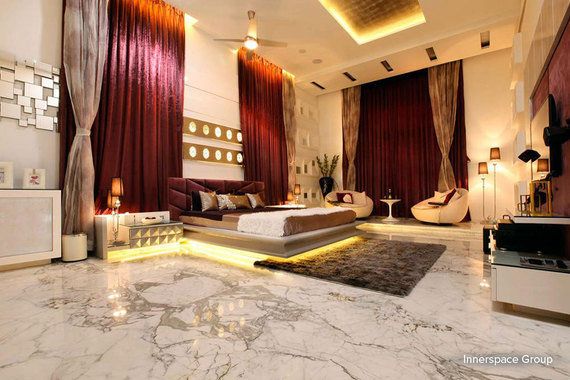
A well-lit home is the key to a comfortable and relaxed atmosphere. Once conceived as purely functional, lighting has now evolved to becoming a key aesthetic element in a home's décor. But here's the thing: décor lighting is tricky. The irony of the situation lies in the fact that impeccable lighting is rarely noticed, unlike lighting that is too bright or too dim.
But lighting design is not rocket science. You don't have to spend tons of money or be an expert to create a perfectly lit home.
Types of lighting
First of all, note that there are three basic types of lighting: ambient, task and accent. Each type meets a particular requirement and a good light design smartly layers all three to suit your requirements. Decorative lighting is purely aesthetical and not necessarily illuminating.
1. Ambient or general lighting: This is the most basic form of illumination wherein you create uniform diffused lighting in any space. It's the first light you switch on when you enter any space. Ambient lights are purely functional. These come in the form of cove lights in ceilings, recessed lights, wall washers, etc. Even sunlight is ambient light!
2. Accent or feature lighting: This form of lighting is used to highlight a specific area, feature wall, artwork, a plant or any picturesque setting.
3. Task lighting: Purely practical, task lighting is used to illuminate a particular function in specific areas, such as table lamps on desks, lights over the dresser, kitchen counter lights, etc. These come in the form of track lights, pendants, under-cabinet lighting strips, table lights and even portable lamps.
4. Decorative lighting: Decorative lighting is purely for ornamentation and to make a style statement. It is not meant for illumination. They should be considered last and must produce the least amount of light. Decorative lights must create the illusion of providing ambient illumination. Decorative lighting must never be considered as a source of illumination as the effect can be garish. Some common examples of decorative lighting are chandeliers, pendant lights, wall sconces, etc.
Lighting by space
The kind of lighting you pick for each of a room has a lot to do with how often the space is used and for which purpose.
1. Living room
Your living room can play a variety of roles. It must host guests and provide an intimate space for families to gather for a post-dinner chat. It may serve as an informal working space or as a place for merriment and togetherness. The furniture plans are less static and the lighting too should be as flexible and accommodating.

This dainty and elegant living room is unpretentious yet classy. While the room is dressed in beige and nude tones, the spotlights add a bit of drama. The accent lighting in the recessed wall beautifully emphasises the texture of the walls and draws the eye to the painting. This living room is an example of flawless lighting that leads the line of vision towards the most aesthetic elements in the space.

This room is our personal favourite. The designer really knows his lights! Cove lights provide ample and comfortable ambient lighting. Spotlights are placed at all the right places to showcase the pretty Mediterranean window and feature wall. The hanging lights add a lovely dimension to the space and summarise the oriental look perfectly.

The chandelier sparkles like a jewel in this living room. But notice how the lights are mellow and it is the recessed lights in the ceiling that provide ambient lighting. The chandelier plays its role perfectly here -- that of a dazzling show-stopper!
2. Kitchens
Kitchens should be as inviting as the rest of the house rather than just a place to slave. Our culture is becoming more relaxed and this is reflected in the trend for open-plan kitchens.
Functionally too, the kitchen is one of the most important areas of the house and it is imperative that anyone working or spending time in one must feel comfortable and relaxed.

Functional and fashionable, this kitchen is perfectly illuminated at every nook and corner. While the dining area overlooked by pendant lights, it is the cove that illuminates the space; the pendants are dimmed to a minimum.
3. Bedrooms
Bedrooms are for rest and relaxation as well as for reading at bedtime. To suit these functions, bedroom lights should be flexible to accommodate various utilities.

The room is lit in soft and warm ambient lights. Bracket lights on the wall double up as accent as well as task lights. Uplighters on the floor beautifully highlight the jaali panelling on the wall The light travels upwards and diminishes at eye level, ensuring that the wall is showcased in a way that doesn't interfere with or disturb the décor.

We see numerous light fixtures in this room that sync subtly with the finishes, upholstery and textures. The ambient lighting creates a perfect backdrop and other elements glow in their own illumination. Brilliantly designed coves highlight the texture in the false ceiling, floor lamps cast a very subtle but pretty glare downwards and the under-bed lighting renders a floating look to the bed. The shadows are independent of each other. None of the lights hinders any function or gets overbearing.
4. Bathrooms
Apart from being functional, bathroom lighting should be suitable, and indeed flattering, for grooming purposes. The lights should not create any unsightly shadows or glare when you look into the mirror. Intrinsically, one feels good when one looks good. So for psychological reasons too, it is essential that your bathroom lighting must be absolutely bang on!

The most common mistake in bathrooms is to place lights directly over the mirror. But here the light is placed at the sides and away from the mirror which creates no unsightly shadows. The chandelier is a decorative light and at a distance from the mirror. It adds a warm glow to the space.

Successful lighting keeps to the backstage and complements the décor. A good illumination design is like makeup. You must use it in such a way that it should highlight beautiful features and not the light or makeup itself.